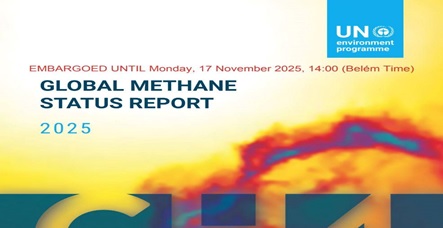08 December, 2025
Global Methane Status Report, 2025
Tue 18 Nov, 2025
Context:
- The United Nations Environment Programme (UNEP) and the Climate and Clean Air Coalition (CCAC) released the Global Methane Status Report, 2025 during the United Nations Climate Change Conference (COP30).
Key Points:
- The report assesses the role of methane in global warming and evaluates global progress in reducing methane emissions.
- It emphasises immediate action in the energy, agriculture, and waste sectors, highlighting that opportunities for up to 70% reduction are cost-effective.
Major Findings:
- Methane Status: Methane absorbs 84 times more heat than CO₂, and its atmospheric concentration has increased 2.5 times since pre-industrial levels.
- Emission Levels: Emissions in 2020 were 352 million tonnes (Mt), projected to rise to 369 Mt by 2030.
- Energy Sector Contribution:
In 2024, the energy sector emitted about 145 Mt methane:
– Oil operations: 45 Mt
– Natural gas operations: 35 Mt
– Coal mining: 40 Mt
– Abandoned wells: 3 Mt
- Global Efforts:
- A total of 159 countries have joined the Global Methane Pledge (GMP), but major emitters such as China, India, and Russia are still not part of it.
- Current commitments and policies are insufficient to meet the GMP target of a 30% collective reduction by 2030 (from 2020 levels).
- With existing implementation, emissions are expected to decline by only 8% by 2030.
Reduction Opportunities:
- Technical Solutions:
Up to 70% reduction is feasible through:
– Leak detection
– Low-emission equipment
– Restrictions on flaring (burning methane)
- Cost-effectiveness:
These measures are economically viable because captured methane can be sold as fuel.
Major Emitting Sectors:
- Agriculture: ~42% (mainly livestock and rice cultivation)
- Energy: ~38% (oil, gas, and coal mining)
- Waste: ~20%
India’s Position:
- Third-largest methane emitter globally.
- Emissions in 2020: ~3 million tonnes, around 9% of global methane emissions.
- Agriculture is the largest contributor: India accounts for 12% of global agricultural methane, the highest in the world.
- Major sources: Livestock and rice cultivation.
- The report states that India has pathways to reduce methane from rice systems, livestock, and waste management, but the identification and implementation of technologies still need scaling.
Global Methane Pledge (GMP) – Target 2030:
- Launched: During COP-26, co-led by Canada and the European Union.
- Membership: 159 countries + European Commission.
- Main Commitment: Reduce global methane emissions by at least 30% by 2030 compared to 2020 levels.
- Alignment with climate goals: Supports the 1.5°C target while improving health, food security, and economic outcomes.
- Champions Group: Supported by Canada, the EU, Germany, Japan, Micronesia, Nigeria, and the UK.
Methane Gas :
- Chemical Formula: CH₄
- Simplest hydrocarbon
- Colourless, odourless, highly flammable gas
- Major component of natural gas: About 70–90%
- Second most influential greenhouse gas after CO₂
Natural Sources:
- Wetlands: Methane produced through bacterial decomposition of organic matter.
- Biological decomposition: Rice cultivation and emissions from ruminant animals (cattle, sheep).
- Fossil fuels: Methane released from coal mines, oil, and gas fields.
- Marine hydrates: Ice-like methane trapped in deep-sea sediments (methane hydrates).


















